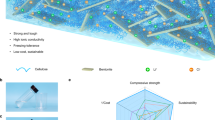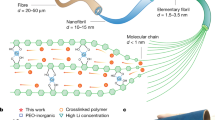Abstract
Converting low-grade heat into useful electricity requires a technology that is efficient and cost effective. Here, we demonstrate a cellulosic membrane that relies on sub-nanoscale confinement of ions in oxidized and aligned cellulose molecular chains to enhance selective diffusion under a thermal gradient. After infiltrating electrolyte into the cellulosic membrane and applying an axial temperature gradient, the ionic conductor exhibits a thermal gradient ratio (analogous to the Seebeck coefficient in thermoelectrics) of 24 mV K–1—more than twice the highest value reported until now. We attribute the enhanced thermally generated voltage to effective sodium ion insertion into the charged molecular chains of the cellulosic membrane, which consists of type II cellulose, while this process does not occur in natural wood or type I cellulose. With this material, we demonstrate a flexible and biocompatible heat-to-electricity conversion device via nanoscale engineering based on sustainable materials that can enable large-scale manufacture.
This is a preview of subscription content, access via your institution
Access options
Access Nature and 54 other Nature Portfolio journals
Get Nature+, our best-value online-access subscription
$29.99 / 30 days
cancel any time
Subscribe to this journal
Receive 12 print issues and online access
$259.00 per year
only $21.58 per issue
Buy this article
- Purchase on Springer Link
- Instant access to full article PDF
Prices may be subject to local taxes which are calculated during checkout




Similar content being viewed by others
Data availability
The data that support the plots in this paper and other findings of this study are available from the corresponding author upon reasonable request.
References
Yari, M., Mehr, A. S., Zare, V., Mahmoudi, S. M. S. & Rosen, M. A. Exergoeconomic comparison of TLC (trilateral Rankine cycle), ORC (organic Rankine cycle) and Kalina cycle using a low grade heat source. Energy 83, 712–722 (2015).
Rahimi, M. et al. Emerging electrochemical and membrane-based systems to convert low-grade heat to electricity. Energy Environ. Sci. 11, 276–285 (2018).
Chen, H., Goswami, D. Y. & Stefanakos, E. K. A review of thermodynamic cycles and working fluids for the conversion of low-grade heat. Renew. Sustain. Energy Rev. 14, 3059–3067 (2010).
Lee, S. W. et al. An electrochemical system for efficiently harvesting low-grade heat energy. Nat. Commun. 5, 3942 (2014).
Yang, Y. et al. Charging-free electrochemical system for harvesting low-grade thermal energy. Proc. Natl Acad. Sci. USA 111, 17011–17016 (2014).
He, M., Qiu, F. & Lin, Z. Towards high-performance polymer-based thermoelectric materials. Energy Environ. Sci. 6, 1352–1361 (2013).
Culebras, M., Gómez, C. & Cantarero, A. Review on polymers for thermoelectric applications. Materials 7, 6701–6732 (2014).
Zhao, D. et al. Ionic thermoelectric supercapacitors. Energy Env. Sci. 9, 1450–1457 (2016).
Kim, S. L., Lin, H. T. & Yu, C. Thermally chargeable solid-state supercapacitor. Adv. Energy Mater. 6, 1600546 (2016).
Bonetti, M., Nakamae, S., Roger, M. & Guenoun, P. Huge Seebeck coefficients in nonaqueous electrolytes. J. Chem. Phys. 134, 114513 (2011).
Abraham, T. J., MacFarlane, D. R. & Pringle, J. M. High Seebeck coefficient redox ionic liquid electrolytes for thermal energy harvesting. Energy Environ. Sci. 6, 2639–2645 (2013).
Poehler, T. O. & Katz, H. E. Prospects for polymer-based thermoelectrics: state of the art and theoretical analysis. Energy Environ. Sci. 5, 8110–8115 (2012).
Würger, A. Thermal non-equilibrium transport in colloids. Rep. Prog. Phys. 73, 126601 (2010).
Dietzel, M. & Hardt, S. Thermoelectricity in confined liquid electrolytes. Phys. Rev. Lett. 116, 225901 (2016).
Rowell, R. M. Handbook of Wood Chemistry and Wood Composites 2nd edn (CRC Press, 2012).
Zhu, M. et al. Highly anisotropic, highly transparent wood composites. Adv. Mater. 28, 5181–5187 (2016).
Dietzel, M. & Hardt, S. Flow and streaming potential of an electrolyte in a channel with an axial temperature gradient. J. Fluid Mech. 813, 1060–1111 (2017).
Zhu, H. et al. Wood-derived materials for green electronics, biological devices, and energy applications. Chem. Rev. 116, 9305–9374 (2016).
Nishimura, H., Okano, T. & Sarko, A. Mercerization of cellulose. 5. Crystal and molecular structure of Na-cellulose I. Macromolecules 24, 759–770 (1991).
Saito, T., Kimura, S., Nishiyama, Y. & Isogai, A. Cellulose nanofibers prepared by TEMPO-mediated oxidation of native cellulose. Biomacromolecules 8, 2485–2491 (2007).
Zugenmaier, P. in Crystalline Cellulose and Derivatives: Characterization and Structures (ed. Zugenmaier, P.) (Springer, 2008).
Mao, Y. et al. Phase separation and stack alignment in aqueous cellulose nanocrystal suspension under weak magnetic field. Langmuir 34, 8042–8051 (2018).
Hopkins, J. B., Gillilan, R. E. & Skou, S. Bioxtas raw: improvements to a free open-source program for small-angle X-ray scattering data reduction and analysis. J. Appl. Crystallogr. 50, 1545–1553 (2017).
Acknowledgements
The work has no direct funding support. We acknowledge the constructive discussions with B. Dunn from the University of California, LA. We thank H. Jiang and D. Ji for the assistance with the BET analysis. We thank Y. Mao and C. Gagnon for the assistance with the SANS measurements. Access to the NGB-30 m SANS beamline at the NIST Center for Neutron Research was provided by the Center for High Resolution Neutron Scattering, a partnership between the National Institute of Standards and Technology and the National Science Foundation under agreement no. DMR-1508249. S. Stoupin’s assistance with the synchrotron WAXS experiment at the A1 beamline of Cornell High Energy Synchrotron Source (CHESS) was greatly appreciated. CHESS is supported by the NSF award no. DMR-1332208. We also acknowledge the support of the Maryland NanoCenter and its AIMLab.
Author information
Authors and Affiliations
Contributions
L.H. and T.L. conceived the idea and supervised the project. X.Z., T.L. and R.M.B. contributed to the structural characterization. T.L., R.M., F.J., J.S., J.D. and Y.Y. contributed to material preparation and characterization. T.L., S.D. and G.C. contributed to the analysis of the ionic transport. F.J. and Z.L. determined the charge density. T.L., X.Z. and R.Y. contributed to the thermal analysis. T.L., S.D.L. and L.H. contributed largely to writing, while all authors participated.
Corresponding author
Ethics declarations
Competing interests
L. Hu and T. Li are the inventors of a patent currently pending with the University of Maryland (no. 62/789325, filed 7 January 2019). All the other authors declare that they have no competing interests.
Additional information
Publisher’s note: Springer Nature remains neutral with regard to jurisdictional claims in published maps and institutional affiliations.
Supplementary Information
Supplementary Information
Supplementary Figures 1–26, Supplementary Tables 1,2, Supplementary References 1–6.
Rights and permissions
About this article
Cite this article
Li, T., Zhang, X., Lacey, S.D. et al. Cellulose ionic conductors with high differential thermal voltage for low-grade heat harvesting. Nat. Mater. 18, 608–613 (2019). https://doi.org/10.1038/s41563-019-0315-6
Received:
Accepted:
Published:
Issue Date:
DOI: https://doi.org/10.1038/s41563-019-0315-6
This article is cited by
-
A high-current hydrogel generator with engineered mechanoionic asymmetry
Nature Communications (2024)
-
Nature-inspired interfacial engineering for energy harvesting
Nature Reviews Electrical Engineering (2024)
-
Recent Progress in Improving Rate Performance of Cellulose-Derived Carbon Materials for Sodium-Ion Batteries
Nano-Micro Letters (2024)
-
The effect of delignification ratio on the PMMA occupation in poplar wood cell wall by the macro and micro comparative study
Journal of Wood Science (2023)
-
Highly stable, antiviral, antibacterial cotton textiles via molecular engineering
Nature Nanotechnology (2023)



